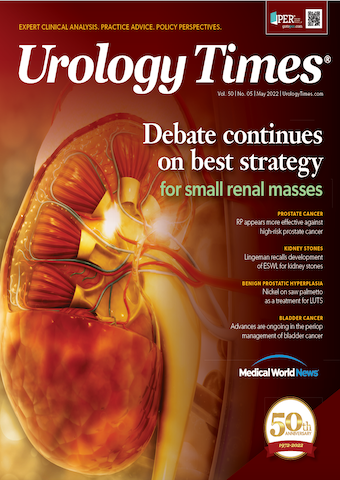Publication
Article
Urology Times Journal
The Gleason grading system: Aging like a fine wine
Author(s):
"As we celebrate 50 years of successes, the Gleason grading system deserves recognition," writes Michael S. Cookson, MD, MMHC.
Michael S. Cookson, MD, MMHC

Few things in science pass the test of time. Among urologic cancers, perhaps more than any other type of tumor, this is especially true of prostate cancer. In terms of prostate cancer, very little can withstand the scrutiny under the microscope and the scientific challenges over the decades. So, as we celebrate 50 years of successes, the Gleason grading system deserves recognition.
Donald Gleason, MD, PhD, devised the “Gleason score” during the 1960s when he was employed by the Minneapolis VA Health Care System. He first published his observations in 1966 based on the assessment of the glandular patterns of cancer present in prostate tissue.1,2
The grading system was modified by Gleason and the Veterans Administration Cooperative Urological Research Group and some additional refinements were made in the mid-1970s.3 The grading system is based on the histologic pattern of arrangement of carcinoma cells in hematoxylin and eosin (H&E) stained sections. The score is presented as the sum of the dominant pattern and the largest minority pattern present in the sample. Five basic grade patterns are used to generate a histologic score, which can range from 2 to 10 with the highest pattern/score representing the most poorly differentiated tumors.
We have learned the power of this grading system over the years. Increasing Gleason grade is directly related to several pathological end points including tumor size, margin status, and pathologic stage. Indeed, models have been developed that allow for pretreatment prediction of pathologic stage based upon needle biopsy Gleason grade, total serum prostate-specific antigen level, and clinical stage.4 Gleason grade has also been linked to several clinical end points including clinical stage, progression to metastatic disease, and overall survival. Gleason grade is often incorporated into nomograms used to predict response to therapy including radiation therapy and surgery.5
Along the way, additional refinements in Gleason grading have been implemented. In 2005, the International Society of Urological Pathology recommended against the use of patterns 1 and 2, resulting in an abbreviated scoring scale of 6 to 10.6 In addition, the consensus recommended that several variant patterns previously graded as 3 and all cribriform patterns be graded as pattern 4. This has resulted in a shift or migration in grading, with a greater number of cancers designated as Gleason score 3+4 and 4+3. This has led to both an improvement in prognostic accuracy and difficulty when comparing historical and contemporary results.
These modifications, for the most part, have led to improved prognostic accuracy. Yet, due to the complexity of communicating prognostic results on a grading scale of 6 to 10, a new grading schema was proposed that consisted of grade groups (GG).7 This was proposed to communicate biologic aggressiveness and to guide clinical management. These prognostic grading groups use a scale of 1 to 5, with GG1 consisting of Gleason 3+3, GG2 (Gleason 3+4), GG3 (Gleason 4+3), GG4 (Gleason 4+4), and GG5 (Gleason 4+5, 5+4, and 5+5). This new modified Gleason grade group classification has been validated to correlate with cancer-specific mortality.
The Gleason grading system and subsequent modifications have been used globally by interdisciplinary teams for the past 50 years to assist in the treatment of men with prostate cancer. Undoubtably, the Gleason grading system will continue to be refined. One debate that has recently resurfaced is a decade-old argument that a Gleason score 6 tumor (GG1) should not be called cancer.8 Admittedly, this is a controversial subject that has proponents and detractors, but it reinforces the concept that the Gleason grading system remains relevant and that contemporizing the nomenclature will only reinforce its value.
So, as we turn to additional tools such as genetic profiling, molecular staining, biomarkers, and artificial intelligence, we will find more accurate tools to enhance our prognostic abilities. However, I predict that for the foreseeable future there will remain a prominent position for the H&E-dependent Gleason grading system in the treatment of men with prostate cancer. Dr Gleason died in 2009, but his grading system lives on and, like a fine wine, improves with time. Thank you, Dr Gleason, for your insightful observations all those years ago. The Gleason grading system has helped us treat (and not treat) millions of men and will continue to be a prognostic staple in our tool chest.
Cookson is a professor at the University of Oklahoma Health Sciences Center, where he is also chairman of the Department of Urology. He is also chief of Urologic Oncology at Stephenson Cancer Center and is president of the Society of Urologic Oncology and the South-Central Section of the American Urological Association.
References
1. Gleason DF. Classification of prostatic carcinomas. Cancer Chemother Rep. 1966;50(3):125-128.
2. Bailar JC 3rd, Mellinger GT, Gleason DF. Survival rates of patients with prostatic cancer, tumor stage, and differentiation—preliminary report. Cancer Chemother Rep.1966;50(3):129-136.
3. Gleason DF. Histological grading and staging of prostatic carcinoma. In: Tannenbaum M, ed. Urologic Pathology: The Prostate. Lea and Feibiger; 1971:171.
4. Partin AW, Mangold LA, Lamm DM, Walsh PC, Epstein JI, Pearson JD. Contemporary update of prostate cancer staging nomograms (Partin Tables) for the new millennium. Urology. 2001;58(6):843-848. doi:10.1016/s0090-4295(01)01441-8
5. Kattan MW, Scardino PT. Prediction of progression: nomograms of clinical utility. Clin Prostate Cancer. 2002;1(2):90-96. doi:10.3816/cgc.2002.n.010
6. Epstein JI, Allsbrook WC Jr, Amin MB, Egevad LL; ISUP Grading Committee. The 2005 International Society of Urological Pathology (ISUP) consensus conference on Gleason grading of prostatic carcinoma. Am J Surg Pathol. 2005;29(9):1228-1242.doi:10.1097/01.pas.0000173646.99337.b1
7. Epstein JI, Egevad L, Amin MB, et al; Grading Committee. The 2014 International Society of Urological Pathology (ISUP) consensus conference on Gleason grading of prostatic carcinoma: definition of grading patterns and proposal for a new grading system. Am J Surg Pathol. 2016;40(2):244-252.doi:10.1097/PAS.0000000000000530
8. Carter HB, Partin AW, Walsh PC, et al. Gleason score 6 adenocarcinoma: should it be labeled as cancer? J Clin Oncol. 2012;30(35):4294-4296. doi:10.1200/JCO.2012.44.0586




























